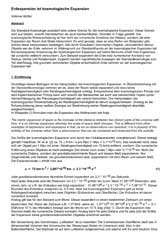Volkmar Müller
Erdexpansion ist kosmologische Expansion
Abstract
Die Standard-Kosmologie postuliert eine untere Grenze für die kosmologische Expansion. Diese Grenze wird aus beiden, sowohl theoretischen als auch beobachtbaren Gründen in Frage gestellt. Die kosmologische Rotverschiebung ist hier nicht als numerische Zunahme der Distanz, sondern als eine Expansion der Raum-Zeit-Skala interpretiert. Es wird gezeigt, dass es eine Reihe von Beispielen gibt, welche diese Interpretation bestätigen. Alle durch Gravitation dominierten Objekte, einschließlich kleiner Objekte wie der Erde, nehmen im Widerspruch zur Standardtheorie an der kosmologischen Expansion teil. Bei konsequenter Anwendung der kosmologischen Expansion auf kleine Bereiche erhält man Ergebnisse, die zunächst vielleicht verwundern. Z.B. expandiert die Erde trotz numerischer Konstanz von Radius, Dichte und Rotationszeit. Zugleich werden hypothetische Aussagen der Standardkosmologie zum Teil überflüssig. Alle gravitativ dominierten Objekte, einschließlich Erde, nehmen an der kosmologischen Expansion Teil.
Erdexpansion ist kosmologische Expansion
Abstract
Die Standard-Kosmologie postuliert eine untere Grenze für die kosmologische Expansion. Diese Grenze wird aus beiden, sowohl theoretischen als auch beobachtbaren Gründen in Frage gestellt. Die kosmologische Rotverschiebung ist hier nicht als numerische Zunahme der Distanz, sondern als eine Expansion der Raum-Zeit-Skala interpretiert. Es wird gezeigt, dass es eine Reihe von Beispielen gibt, welche diese Interpretation bestätigen. Alle durch Gravitation dominierten Objekte, einschließlich kleiner Objekte wie der Erde, nehmen im Widerspruch zur Standardtheorie an der kosmologischen Expansion teil. Bei konsequenter Anwendung der kosmologischen Expansion auf kleine Bereiche erhält man Ergebnisse, die zunächst vielleicht verwundern. Z.B. expandiert die Erde trotz numerischer Konstanz von Radius, Dichte und Rotationszeit. Zugleich werden hypothetische Aussagen der Standardkosmologie zum Teil überflüssig. Alle gravitativ dominierten Objekte, einschließlich Erde, nehmen an der kosmologischen Expansion Teil.
Volkmar Müller
Volkmar Müller
The Cosmological Expansion of Small Regions and of the Earth
Abstract
In contradiction to standard cosmology, this paper shows that cosmological expansion can be found in objects the size of the Earth. According to standard big bang cosmology, based on general relativity, cosmological expansion exists only at scales larger than galaxies. The Earth, being much smaller, should not expand as the result of cosmological expansion. This paper asserts that standard cosmology has two main shortcomings: 1) It equates cosmological expansion with radial velocity, which this paper argues is not true, and 2) it treats as coincidence that the Earth’s rotational delay is equal to the Hubble constant, a measure of cosmological expansion (both values match to 18 orders of magnitude).
Other measurements and calculations also match the rate of cosmological expansion. These include 1) the growth of the Earth’s polar radius, 2) expansion of the Moon’s orbit, 3) the anomalous acceleration of Pioneer Probes 10 and 11, and 4) the expansion rates of early galaxies. Because the expansion or retardation rates are nearly identical, this leads to the assumption that all of these phenomena have the same cause. If they do, this contradicts the basic postulate that cosmological expansion exists only at distances greater than galaxies.
A number of conclusions result from the evidence that cosmological expansion exists at small scales. A minimum Earth expansion would be set at 0.06 cm per year. Likewise, the Earth would slow down at a rate fixed by this expansion (pirouettes effect). The author argues, contrary to standard theory, that cosmological expansion exists at scales dominated by gravity. Once the dominant force becomes electromagnetic, the expansion stops. The Earth which is dominated by gravity expands. The continents which are bound by electromagnetic forces do not.
G. Scalera, E. Boschi and S. Cwojdzi ´nski (eds.), 2012
THE EARTH EXPANSION EVIDENCE – A Challenge for Geology, Geophysics and Astronomy
Selected Contributions to the Interdisciplinary Workshop of the 37th International School of Geophysics
EMFCSC, Erice (4-9 October 2011)
The Cosmological Expansion of Small Regions and of the Earth
Abstract
In contradiction to standard cosmology, this paper shows that cosmological expansion can be found in objects the size of the Earth. According to standard big bang cosmology, based on general relativity, cosmological expansion exists only at scales larger than galaxies. The Earth, being much smaller, should not expand as the result of cosmological expansion. This paper asserts that standard cosmology has two main shortcomings: 1) It equates cosmological expansion with radial velocity, which this paper argues is not true, and 2) it treats as coincidence that the Earth’s rotational delay is equal to the Hubble constant, a measure of cosmological expansion (both values match to 18 orders of magnitude).
Other measurements and calculations also match the rate of cosmological expansion. These include 1) the growth of the Earth’s polar radius, 2) expansion of the Moon’s orbit, 3) the anomalous acceleration of Pioneer Probes 10 and 11, and 4) the expansion rates of early galaxies. Because the expansion or retardation rates are nearly identical, this leads to the assumption that all of these phenomena have the same cause. If they do, this contradicts the basic postulate that cosmological expansion exists only at distances greater than galaxies.
A number of conclusions result from the evidence that cosmological expansion exists at small scales. A minimum Earth expansion would be set at 0.06 cm per year. Likewise, the Earth would slow down at a rate fixed by this expansion (pirouettes effect). The author argues, contrary to standard theory, that cosmological expansion exists at scales dominated by gravity. Once the dominant force becomes electromagnetic, the expansion stops. The Earth which is dominated by gravity expands. The continents which are bound by electromagnetic forces do not.
G. Scalera, E. Boschi and S. Cwojdzi ´nski (eds.), 2012
THE EARTH EXPANSION EVIDENCE – A Challenge for Geology, Geophysics and Astronomy
Selected Contributions to the Interdisciplinary Workshop of the 37th International School of Geophysics
EMFCSC, Erice (4-9 October 2011)
* kleine Schrift:
noch kein Text/
noch im Aufbau
noch kein Text/
noch im Aufbau
Geologische Zeittafel




